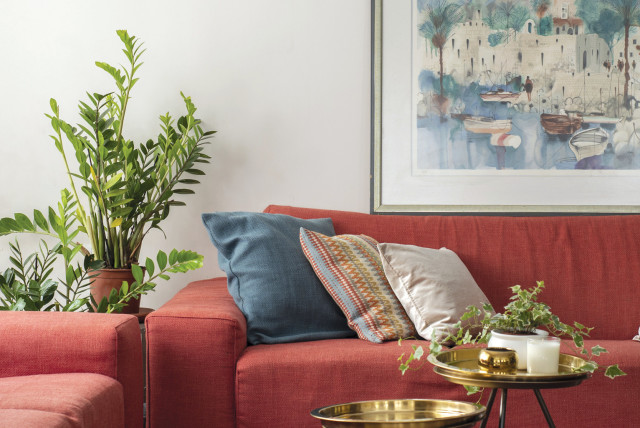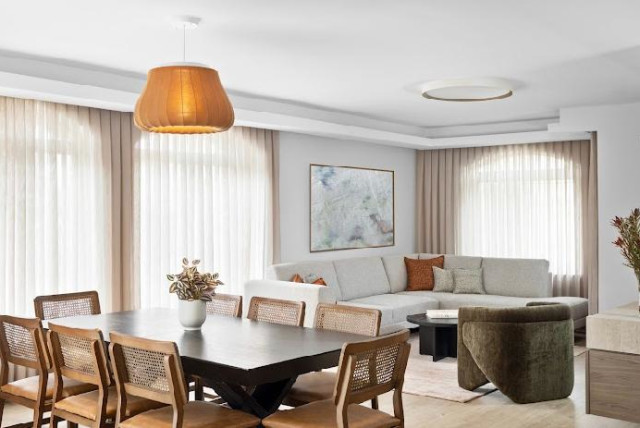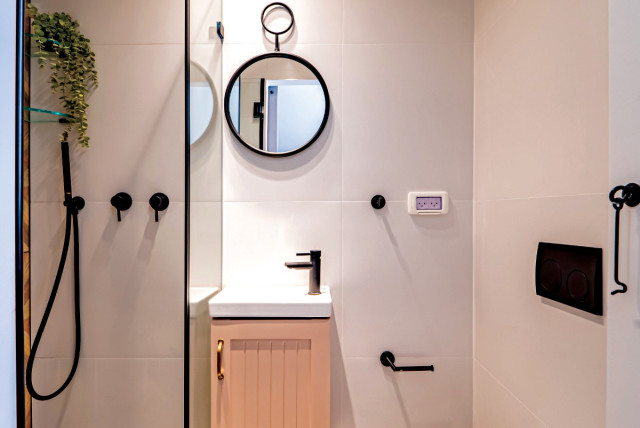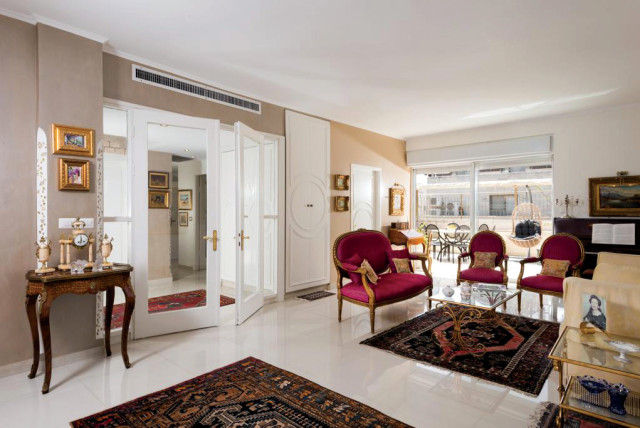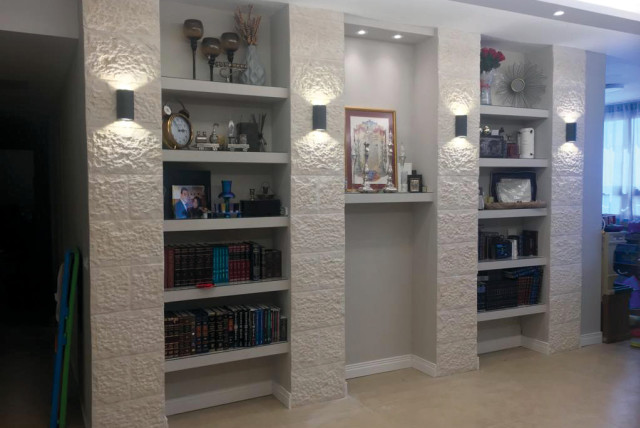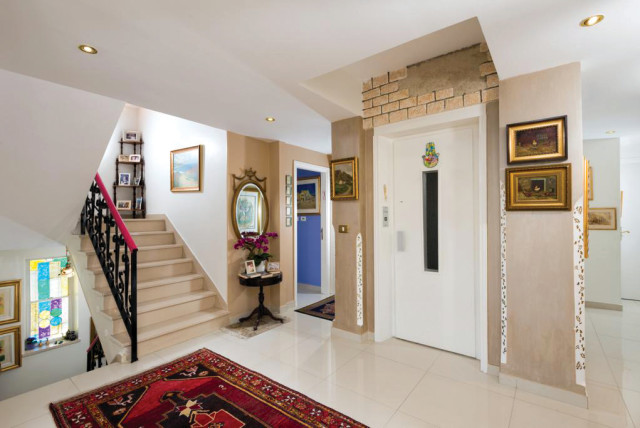Jerusalem-inspired interior design: Giving homes an Israeli capital feel
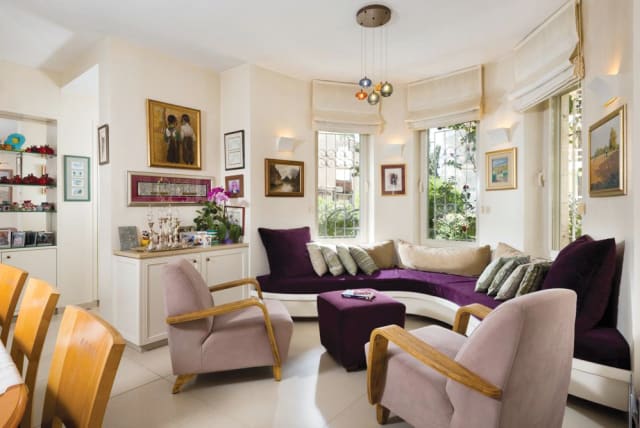
English-speaking interior designers living in Israel discuss how they recreate the Jerusalem look on the inside.
“The view of Jerusalem is the history of the world; it is more, it is the history of earth and of heaven,” said Benjamin Disraeli. And Jerusalem’s unique architecture reflects that, too. Golden stones carved of ancient rocks dating back from myriad civilizations can be found everywhere you look. We bask in the vistas of history and culture.
However, as unique as Jerusalem’s ancient architecture is, new looming high-rises have been changing the skyline in neighborhoods all across the city.
I asked an English-speaking Israeli group of interior designers that I belong to how they manage to reflect Jerusalem inside the homes and apartments that they design.
Sandy Brudner – Sandy B Interiors
Sandy Brudner designs homes throughout Jerusalem, including garden apartments, penthouses and apartments in high-rise buildings. Many of her clients are English-speaking immigrants, and some are feathering their vacation home nest prior to moving to Israel.
She loves designing homes in Jerusalem and feels blessed that, through her work and passion, she is making Jerusalem beautiful, home by home.
“I also feel fortunate to be able to see Jerusalem’s different landscapes from the numerous apartments I’ve designed in high-rise buildings,” she said. “Seeing Jerusalem’s beauty from up high is awe-inspiring and breathtaking.”
Brudner, originally from Toronto, lives in Katamon and has been in business for 16 years. When she designs, she works with her clients to bring the unique aspects of Jerusalem into the home in many ways.
When one client, a new olah, said she wanted her apartment to have a Jerusalem Old City feel, Brudner asked her specifically what the Old City in Jerusalem meant to her.
“I wanted to see what features she really wanted,” Brudner explained.
And then Brudner took a walk to the Old City to soak up the ambiance she could reflect in the home.
“I saw arches and texture everywhere and decided to incorporate the look into the home,” she recalled. “I incorporated arches as soon as you walk from foyer to the kitchen, dining room, living room entryway. I put a glass arch insert over the pocket door leading into the main room.”
The arches were even reflected in the shape of the rounded breakfast bar and in the dropped ceiling.
She played up the theme of arches to create a hand-washing station (netilat yadayim), cabinet and sink.
“The textured sink looks like Jerusalem stone,” she explained. “I wanted to incorporate the layers of Jerusalem, so I sunk it into the counter top to reveal the texture from the outside, as opposed to laying it atop the cabinet. The design worked better with the rim.”
Gold is a very popular color in Jerusalem, according to Brudner – it makes Jerusalem sparkle and shine.
“I’m not into trends,” she continued. “I like to design interiors based on what my clients’ vision and character are, and to design homes that our clients can enjoy for many years to come.
“To this client, it was important to have stone and to have the idea of the Kotel in her home. I put stone over the buffet in the dining room. We inserted stone within the niches. Niches reflect a particular street in the Old City – the space between two buildings in the stone of the Kotel. It’s conceptual.
“In the kitchen, we used stone painted tiles to give the idea of mosaic without using actual mosaic, inset into the backsplash instead of freestanding, just as you can find a splash of color and different styles with a bold punch of color, which in the Old City is frequently blue or green.
“I especially like the mix of the old and the new. The old is in our DNA, but we and our families are moving into the future, and I like the fact that the design melds the two together.
“There are the historical buildings that retain the history and the new designs,” she said.
When a home has beautiful views, Brudner works to use them.
While designing an apartment in King David Crown that had beautiful views from the windows, she took advantage of the three exposures that gave a series of different vantage points.
She tells anyone interested in using a Jerusalem motif inside the home to go for walking tours throughout Jerusalem. She suggests that they immerse themselves and stop to look at details.
“The smallest details say so much and can inspire you to be creative,” she said. “A doorknob, the colors splashed through an alleyway – all those can be inspiring. I love Jerusalem doors and losing myself within the different neighborhoods.”
Natalie Sher – Natalie Sher Interiors
When Modi’in designer Natalie Sher was asked to design a six-bedroom holiday home in Ramot, the clients wanted it to reflect Jerusalem through and through.
Sher used colors – sandy and gold tones – to reflect the “golden” feeling of Jerusalem, and she procured Israeli art to further the effect throughout the home.
She created a niche for the netilat yadayim station adjacent to the dining area.
“We were looking for something that looked beautiful,” she explained. “The sandy tones, the gold of the faucet, reflect the ‘gold’ feeling of Jerusalem.”
The master bedroom, framed by a wraparound garden outside with fruit trees, was an exciting feature of the home.
“We reimagined this to create an inside-outside flow. The wraparound garden outside, with all the glorious fruit trees – citrus, pomegranates and more – can now be enjoyed even from inside the bedroom. The clients wanted to feel like they were living in a garden. We moved the bed and used earthy and neutral colors inside to make the room feel grounded and calm, a serene space. We used natural linens so the interior can be at one with the view, to make the inside and outside symbiotic.”
The inside-outside flow was familiar for the Australian-born designer to create, as in Sydney the climate is friendly, and design is always about bringing the outside world in.
In a Jerusalem high-rise apartment on the 11th floor, overlooking the golden rooftops of Jerusalem, Sher created a worn, neutral palette, integrating the sky as part of the interior design.
“As the light changes, the northeastern exposure makes the interior look magical,” Sher explained. “Light-colored curtains enhance the view without distracting. The apartment was chosen for the view that was so central to the design.”
In one Ramot home, Sher changed the shape of the window in the living room/dining room to create arches atop the windows. She said that while it isn’t an original old Arab home, it now reflects the signature style of Jerusalem homes.
In another Ramot home, the kitchen overlooks a courtyard. Sher kept the warm wood-colored tones in the parquet tiles and barstool seats, but the rest of the kitchen is white.
“The owners were North American and wanted Shaker frame cabinets,” Sher recalled. “The colors softened the space, giving it a warm, traditional vibe. This kitchen is the heart of the home.”
Sher said that guided research helps the family figure out what Jerusalem is to them – in terms of the feeling. If it is a big old Arab home, it will look quite different than if it is a high-rise. Sometimes her design is more interpretative and less literal, like the netilat yadayim spot in the Ramot home, which reflects the neutral colors but has more modern tiles and fixtures.
She suggested that before you decide on your interior Jerusalem look, answer some questions. What do you love about Jerusalem? Is it the colors, the clouds, the lighting at dawn and dusk? Are you building a vacation home, or will you live in it full time? Ultimately, she says, it should make sense, have good flow and create a lovely feel.
Sher enjoys the challenge of working with clients who aren’t from Israel and may not be aware of the limitations they may encounter in designing their homes. Properties are smaller, and some things don’t make sense here because of climate and lighting.
“Israel is at the forefront of design,” said Sher. “Everything in the world is available to us, although it may have to be tweaked for climate. It isn’t just about utility anymore. Lightness and brightness are key here. Soft, neutral lighting emphasizes the natural beauty of Israel. And we have great space-saving solutions.”
Ari Weiss Interiors
Ari (short for Ariella) Weiss arrived in Israel from Los Angeles in 2002 and lived in Ramot, Rehavia, Katamon and Baka before landing in her current home in Tzur Hadassah.
“There is so much more to Jerusalem design than stone,” she said emphatically. “When I think about my Jerusalem designs, especially in the Anglo homes I design in Baka, the first thing I do is connect to the overall area we live in.”
Unlike designers who embrace the neutral, Weiss uses a color often seen in Sephardi and Arabic design – blue.
“The color blue is spiritual – a very important color, so I’ve created a lot of blue doors and cabinets,” she explained. “I also use Middle Eastern colors like bright red. I love tile designs that have an Arabic feel that connects us to who we are geographically and spiritually; and, of course, colors that tie us to the nature all around us.”
When she first meets with a client, she starts by talking about the houses and Jerusalem. “Everyone feels something about Jerusalem. It’s the center of the whole world, and it speaks to me.”
One bathroom she designed had a pseudo-concrete floor, which she described as primal Jerusalem. The tile looks and feels like concrete, and the wall tiles in the bathroom are reminiscent of bricks.
For a Rehavia living room with lots of trees outside, she chose wooden wallpaper and built a divider of real wood slats separating the kitchen from the living room. Like many Jerusalem kitchens, the clean and white are designed to bring the outside in.
In Baka, Weiss designed a blue kitchen, with blue wall tiles and cabinets.
“It was in a private house, a historical neighborhood, with Oriental roots,” she explained. “The design includes handmade tiles by Vera and Dafna in Talpiot. Arches in the door window reflect the Middle Eastern design look.”
She incorporated butcher block to give the kitchen an earthy look. She said the wood epitomizes nature, geography and history of where we are. “You won’t find shiny kitchen cabinets in my Jerusalem designs!”
For an entry foyer in Tzur Hadassah, Weiss found fabrics in the Christian Quarter of Jerusalem’s Old City and had cushions custom made for the storage bench in the entry.
She said it was the true Jerusalem experience, sitting with the Arab-Christian owner in his hidden shop, drinking coffee and choosing fabrics. His store has a plexiglass window in the floor looking into ancient Jerusalem ruins. Again, reflecting nature, Weiss found a mirror made of cork, rattan baskets, and a rattan plant holder, and surrounded a wooden artifact from the client’s family.
Weiss marveled at the easy access we have in Israel to so many materials that would have had to be imported to the States. Living in the Middle East, she pointed out, we can get Spanish and Italian tiles, and goods from the Far East as well.
“We can easily pop over to the Design Expo in Milan, Italy,” she said. “We are right in the middle – we can easily get the trends and the materials.”
Muriel Davis Interiors
Muriel Davis has lived in Baka for over 30 years and continues to be inspired by the colors outside her window. She has a passion for the eclectic, which she said reflects the theme of the ingathering of the exiles that is happening in Jerusalem. In one room she designed, she features Oriental rugs, French furniture, an Italian coffee table and painted windows reminiscent of Chagall because Jews converge in Jerusalem from all over the world.
She frequently uses cream color paint surrounded by gold borders to signify the colors of Jerusalem stone. One living room she designed features an antique coffee table she stumbled upon while shopping in the Old City in a shop in the American Colony Hotel. She enjoys shopping expeditions in Jerusalem, where shop owners offer to take her behind the curtain to view the hidden treasures they save for interior designers.
“Pendant lamps remind me of domed buildings,” she said. “And I choose paintings that reflect Jerusalem. I like Kotel and Old City scenes.”
A green kitchen she designed in one neighborhood reflects the olive groves in the valley next to the Israel Museum, the vicinity of this house. The colors of the kitchen pick up the colors from outside the window. Green walls, olive green counters, off-white cabinets are all echoes of outside counterparts. The living room in this home overlooks the valley and picks up the cream and green colors with lots of green plants.
A Baka bathroom designed in red reflects the fiery red of Jerusalem sunsets, and a peach room reflects the colors of sunrise and morning.
Davis shops mainly in Jerusalem’s Talpiot and in D-City and sometimes visits the Design Center in Bnei Brak.
Yael Wiesner Interior Designs
Yael Wiesner remembers her first trip to Israel at age 11. She looked out of her window and said, “This doesn’t look like Israel.” Only after she visited Jerusalem did she feel she had “seen Israel.”
She said there are many different ways to portray Jerusalem inside the home and give it an Old City feeling. To some clients it is depicted in the artwork, while others have many books in their bookcases. To give the bookcase a taste of Jerusalem, Wiesner has incorporated arches in the structure of the bookcase or used portraits of people praying or studying.
But, ultimately, Jerusalem stone defines Israel. Real Jerusalem stone as a facade must be cut much thinner, but there are also less expensive, strong-quality polymer plastics that are easy to apply and that look real. Each piece covers about one square meter and ranges from NIS 240 to NIS 310 per piece. It is installed with hi-tech professional super glue. ❖
If I forget thee, O Jerusalem… (unfinished wall solutions)
There is a Jewish tradition to leave an unpainted, unfinished square in front of, or over, the main entrance to the home, in memory of the destruction of the Temple in Jerusalem.
Here are a few ideas from our designers for the “remembrance wall”:
- Yael Wiesner, of Yael Wiesner Interior Designs, who lives in Jerusalem and serves many Jerusalem clients, incorporates that square into her overall design.
- Senja Lauderdale, a Gush Etzion- and Jerusalem-based interior designer, suggests artwork by Mandy Broder from The Workshop in Rosh Tzurim.
- Muriel Davis: A plaster Kotel crumbles into the traditional unfinished wall.
The writer is an author and interior designer from Karnei Shomron.
Jerusalem Post Store
`; document.getElementById("linkPremium").innerHTML = cont; var divWithLink = document.getElementById("premium-link"); if (divWithLink !== null && divWithLink !== 'undefined') { divWithLink.style.border = "solid 1px #cb0f3e"; divWithLink.style.textAlign = "center"; divWithLink.style.marginBottom = "15px"; divWithLink.style.marginTop = "15px"; divWithLink.style.width = "100%"; divWithLink.style.backgroundColor = "#122952"; divWithLink.style.color = "#ffffff"; divWithLink.style.lineHeight = "1.5"; } } (function (v, i) { });


